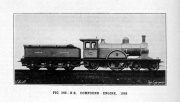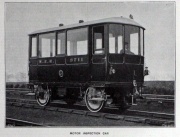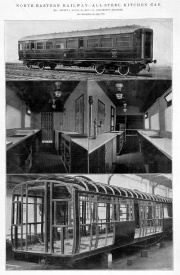Difference between revisions of "North Eastern Railway"
| Line 17: | Line 17: | ||
[[Image:Im090619SR-NER.jpg|thumb| 1875. Exhibit at the [[Shildon Locomotion Museum]]. ]] | [[Image:Im090619SR-NER.jpg|thumb| 1875. Exhibit at the [[Shildon Locomotion Museum]]. ]] | ||
[[Image:Im1880EnV50-p368.jpg|thumb| 1880. Bridge over the river Wear at Sunderland.]] | [[Image:Im1880EnV50-p368.jpg|thumb| 1880. Bridge over the river Wear at Sunderland.]] | ||
[[Image:Im1925EnV140-p394b.jpg|thumb| 1900-1. ]] | |||
[[Image:Im1901Eing-NER.jpg|thumb| 1901. ]] | [[Image:Im1901Eing-NER.jpg|thumb| 1901. ]] | ||
[[Image:Im1904MotAnn-NER.jpg|thumb| 1904. Omnibus running from Beverley to Driffield.]] | [[Image:Im1904MotAnn-NER.jpg|thumb| 1904. Omnibus running from Beverley to Driffield.]] | ||
Revision as of 10:18, 15 August 2012


of York
of Gateshead Works. The North Eastern Railway (NER), unlike many other of the pre-Grouping companies, had a relatively compact territory, having the district it covered to itself. That district extended through Yorkshire, Durham and Northumberland, with outposts in Westmorland and Cumberland. [1]
It formed the middle link between London and Edinburgh, joining the Great Northern Railway near Doncaster and the North British Railway at Berwick-upon-Tweed.
1854 Incorporation took place.
Constituent parts of the NER
- York, Newcastle and Berwick Railway 1854
- York and North Midland Railway 1854
- Leeds Northern Railway 1854
- Malton and Driffield Railway 1854
- York and North Midland Railway 1862
- South Durham and Lancashire Union Railway 1862
- Stockton and Darlington Railway 1863
- West Hartlepool Railway 1865
York station (York) was the hub of the system, and the headquarters of the line was located here.
1877 The basis for the present station was opened on June 25 1877. Until the advent of modern signalling, the 295-lever box was the largest manually-worked signal box in Britain.
Newcastle Central station (Newcastle), opened August 29 1850, became the largest on the NER. Other principal stations were located at Sunderland, Darlington and Hull. The station at Leeds was a joint undertaking with the London and North Western Railway.
1875 See 1875 Number of Locomotives where they are listed second with 1,331 locomotives.
1888 See Locomotive Stock June 1888 where they are listed second with 1,506 locomotives.
1908 The company owns 1,650 miles of road. [2]
The NER was the first railway company in the world to appoint a full-time salaried architect to work with its chief engineer in constructing railway facilities. Some of the men appointed were based in, or active in, Darlington.
- Thomas Prosser held the position from 1854 to 1874. He worked in Newcastle
- Benjamin Burleigh, died after only two years in post.
- William Peachey who followed Burleigh for an equally brief period of office, was based in Darlington and his work had more impact in the town. Peachey had been architect to the Stockton and Darlington Railway, and when this merged into the NER in 1863 was made Darlington section architect. Most of his work was to extend and improve railway buildings, though elsewhere he built the Zetland Hotel at Saltburn (1861-3), and the Royal Station Hotel at York (1877-82). He also practised privately and designed a few nonconformist chapels including Grange Road Baptist Chapel in Darlington, 1870-1.
- William Bell worked for the NER for fifty years and was chief architect between 1877 and 1914. He designed a few buildings in Darlington as a private practitioner, especially for the Methodists, but his major contribution was as NER architect. Bank Top (1884-7) is one of the best examples of his station designs, for which he developed a standard system of roof building, and he added various elements to the North Road Engineering works between 1884 and 1910. He also designed the offices of the Mechanical Engineer's Department in Brinkburn Road in 1912. While not quite as splendid as the Headquarters Offices in York, which he designed with Horace Field in 1904, it shows that Bell could adapt his usual style to accommodate the new influences of the Queen Anne revival.
- Arthur Pollard and Stephen Wilkinson then each filled the position of chief architect briefly, before the merger of 1923 into the LNER led to the abolition of the department.
The NER was the first main line rail company in Britain to adopt electric traction (the Lancashire and Yorkshire Railway followed about one week later). The lines converted were known as Tyneside Electrics:
- Newcastle Central via Wallsend and Whitley Bay to Gosforth
- Newcastle Central to Benton
- the Riverside Loop from Byker to Percy Main
NB Further extensions were carried out in 1938 by the London and North Eastern Railway
The NER carried a larger tonnage of mineral and coal traffic than any other principal railway.
The NER was a partner (with the North British Railway and the Great Northern Railway) in the East Coast Joint Stock operation from 1860.
The company owned the following docks:
- Hull Docks: acquired 1893. Dealt with a large variety of cargoes, including grain, seed and fruit
- Hartlepool Docks: acquired 1865. A large timber trade
- Tyne Dock: opened by NER in 1859. Timber and coal exports
- Middlesbrough Dock: Opened in 1842. Iron and steel exports; and a world-wide trade in other goods.
The NER also owned coal-shipping staithes at Blyth and Dunston-on-Tyne.
1923 It was absorbed into the London and North Eastern Railway at the Grouping in 1923





































































